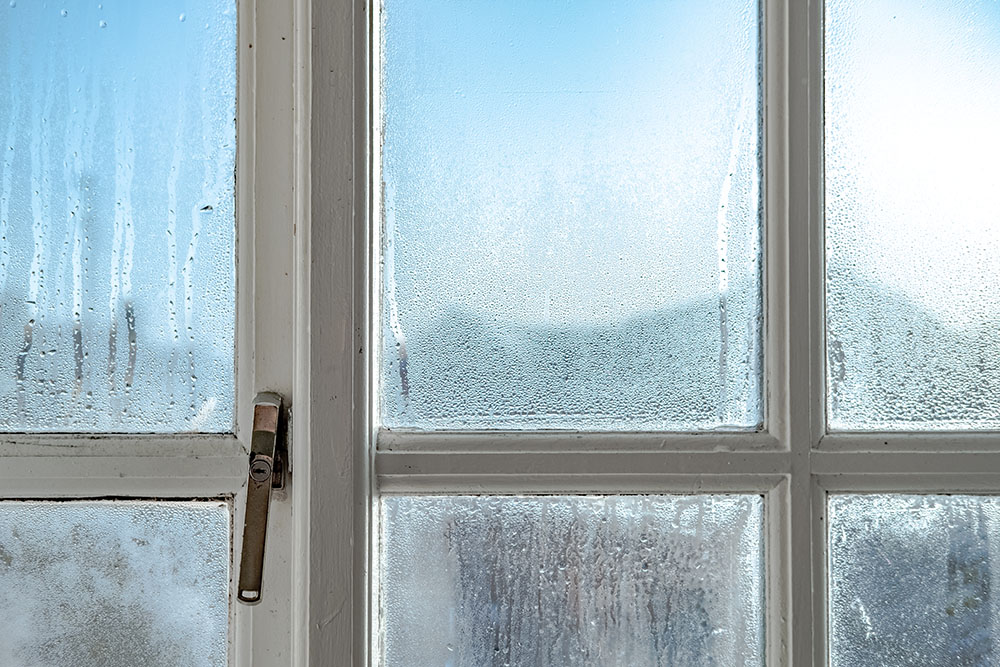Your Mould And Condensation Guide: What To Look For

CONTENTS
- Recognising the signs of mould in your home
- Understanding condensation and its role in mould development
- Investigating common causes of mould and condensation
- Proactive measures to prevent mould and manage condensation
- Health implications of mould exposure
- Monitoring tools and technology for humidity control
- Legal aspects and responsibilities regarding mould in rental properties
- Frequently asked questions
- Get in touch
You might have spotted that patch of discolouration or felt the musty air that lingers too long. These are signs you are dealing with more than just a visual stain; they signal potential health risks and damage to your home.
At ICE Cleaning, we offer mould remediation services that utilise the best solutions and technology available in the UK. Our techniques allow us to identify the root cause of mould, helping you prevent it from returning in the future.
Read on to learn how to recognise mould early on, tackle common causes head-on, and keep them at bay with practical tips.
Recognising the signs of mould in your home
Mould growth may be happening without you noticing, but taking preventive action is easier when armed with visual clues. Find patches of discolouration indicating mould, which can range from darker hues of black and green to lighter tones in the realm of white or yellow.
The texture is another indicator of mould. If you spot areas where the wall seems bumpy or fuzzy, meaning mould might be beneath the surface. You should stay aware of any changes in smell - a musty smell is linked to mould.
Beyond these signs, understanding how dampness affects your health can allow you to remediate it faster. Although some might dismiss it as a nuisance, living alongside mould can affect our well-being.
Understanding condensation and its role in mould development
Condensation is often the source of mould infestations in our homes. It grows when excess moisture in the air hits cold surfaces, leaving a wet film ideal for mould spores to settle and thrive.
A UK home with a family of four generates around 14 litres of water vapour daily from activities like cooking or showering. Without proper ventilation, this moisture has nowhere to go but onto your walls, windowsills, and ceilings - all hotspots for condensation.
To keep your living space free from mould, you have to manage indoor humidity levels. A simple fix like ensuring consistent airflow can make a huge difference; it is about balancing temperature with air quality.
Investigating common causes of mould and condensation
Mould and condensation in your home are often the result of several factors that combine to create the perfect environment for these issues to thrive. It all starts with a lack of ventilation. Homes need to breathe; without proper airflow, moisture lingers longer than it should.
This can happen when windows are closed or extractor fans are not used consistently during cooking or showering. The impact is more than just steamy mirrors; it creates an environment where mould spores thrive and spread.
Your daily routine might also be contributing to condensation build-up. From drying clothes indoors on radiators to boiling kettles frequently throughout the day – each adds humidity to your home’s atmosphere, which can lead to problems if not managed well.
Sometimes buildings cannot keep mould at bay due to structural defects. These can range from leaking pipes hidden within walls, poor insulation causing cold spots where dew forms readily, or ineffective damp proofing, letting ground moisture seep through foundations.
Each of these elements requires attention because they attract mould and can exacerbate it. Unless fixed promptly and professionally by mould cleaning experts, your home may become victim to a large infestation which requires costly remediation.
Proactive measures to prevent mould and manage condensation
Mould and condensation can turn make your home unsafe if not tackled head-on. But, you may be able to take control.
First, observe humidity levels; they are important factors in mould growth. A simple hygrometer can help you monitor this invisible culprit. If readings are high, consider investing in a dehumidifier that works best for your space.
Ventilation is another key part in mould prevention. Open a window or switch on an extractor fan during cooking or showering to filter steam out. You should also regularly adjust radiator vales to maintain consistent indoor temperatures and prevent condensation.
Lastly, keep furniture away from external walls where possible. This lets air flow freely around the room, discouraging mould spores from settling down and growing.
Health implications of mould exposure
When mould grows in your living space, it releases spores and volatile organic compounds (VOCs) into the air. These can spark various health issues — some you might not even suspect are linked to mould.
The most common reactions are respiratory problems like sneezing or coughing. For those with asthma or allergies, these symptoms can feel more intense and cause respiratory irritation.
The NHS highlights the risks for individuals with weakened immune systems as they are more likely to face infections from certain types of moulds.
Beyond breathing troubles, skin and eye irritation is another symptom. Touching or brushing against mouldy surfaces might irritate your skin, causing skin rashes. VOCs can also infiltrate your eyes, causing redness and watering.
For young children, studies have found that they are more likely to develop asthma before they attend school if they live in a home with mould. These can become lifelong issues and may result in respiratory infections.
Monitoring tools and technology for humidity control
Maintaining humidity levels is key to preventing mould. Hygrometers are your first line of defence, giving you precise readings of indoor moisture levels.
Digital versions sync with smartphones, allowing constant vigilance against dampness. A good investment might be a dehumidifier with built-in hygrostats – they switch on when needed, tracking humidity control thoroughly.
To prevent condensation and improve air quality, consider smart ventilation systems. These devices monitor air quality round-the-clock and adjust airflow accordingly – a proactive approach to keep walls dry.
Legal aspects and responsibilities regarding mould in rental properties
Tackling mould is a shared duty. Landlords must ensure homes are habitable and safe, and repair structural issues that could lead to mould. Tenants should act responsibly, keeping the place well-aired and clean.
If there is dampness or a persistent musty smell, you might be exposed to real health hazards. The law sides with tenants here – landlords who do not fix these problems may breach the Housing Health and Safety Rating System (HHSRS).
Tenants must manage lifestyle factors, like drying clothes indoors without proper ventilation, which adds to condensation. Should disputes arise, seeking legal advice or contacting your council for a housing inspection will clear up any confusion.
Frequently asked questions
How do you get rid of mould and condensation?
To tackle mould, contact a professional mould cleaning company. For condensation, boost airflow by venting rooms and using extractor fans.
How do I stop condensation and mould in my bedroom?
Avoid dampness; keep the room warm, and air circulating, and consider moisture-absorbing products to maintain dryness.
Do dehumidifiers stop mould?
Dehumidifiers reduce moisture levels which can help prevent new mould from forming but won't remove existing growth.
Does opening windows help with mould?
Opening windows improves ventilation, reducing humidity that fuels mould. However, it does not remove existing growth.
Get in touch
If you are struggling with mould on your property, get in touch with us at ICE Cleaning. Our specialists offer thorough mould cleaning services across the UK, utilising modern technology and solutions to ensure there is no chance of a repeat infestation.
To learn more about our mould removal services, contact our team at 0208 066 0360 or enquiries@icecleaning.co.uk. We operate nationwide, available 24/7, 365 days a year - so no matter the day or time, we can help as soon as possible.

Speak with me today,
I’m here to help
By asking you a few questions either via phone or email I can immediately provide a realistic estimation of the cost.
You’re in good company. We’ve cleaned for the following commercial clients… View all

Why choose us?
- Cater to a wide variety of cleaning situations
- Nationwide coverage, available 24/7
- Cater to commercial and domestic clients
- Free survey provided prior to quotation
- Emergency response team
- Offer a bespoke service designed to suit all your needs
- All technicians hold professional health and safety qualifications, including BICSc, IOSH, Dewpoint Professional & Safe Contractor
We’re fully accredited
We place best practise, professional expertise and health and safety at the core of our business. We’re fully compliant with all legal obligations. You can view a list of our accreditations below, or visit our Health & Safety page for more information.











-RGB-small.1707319151.jpg)




















